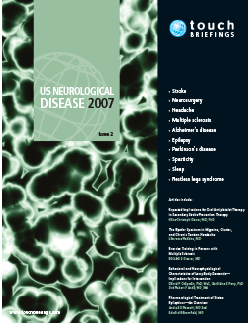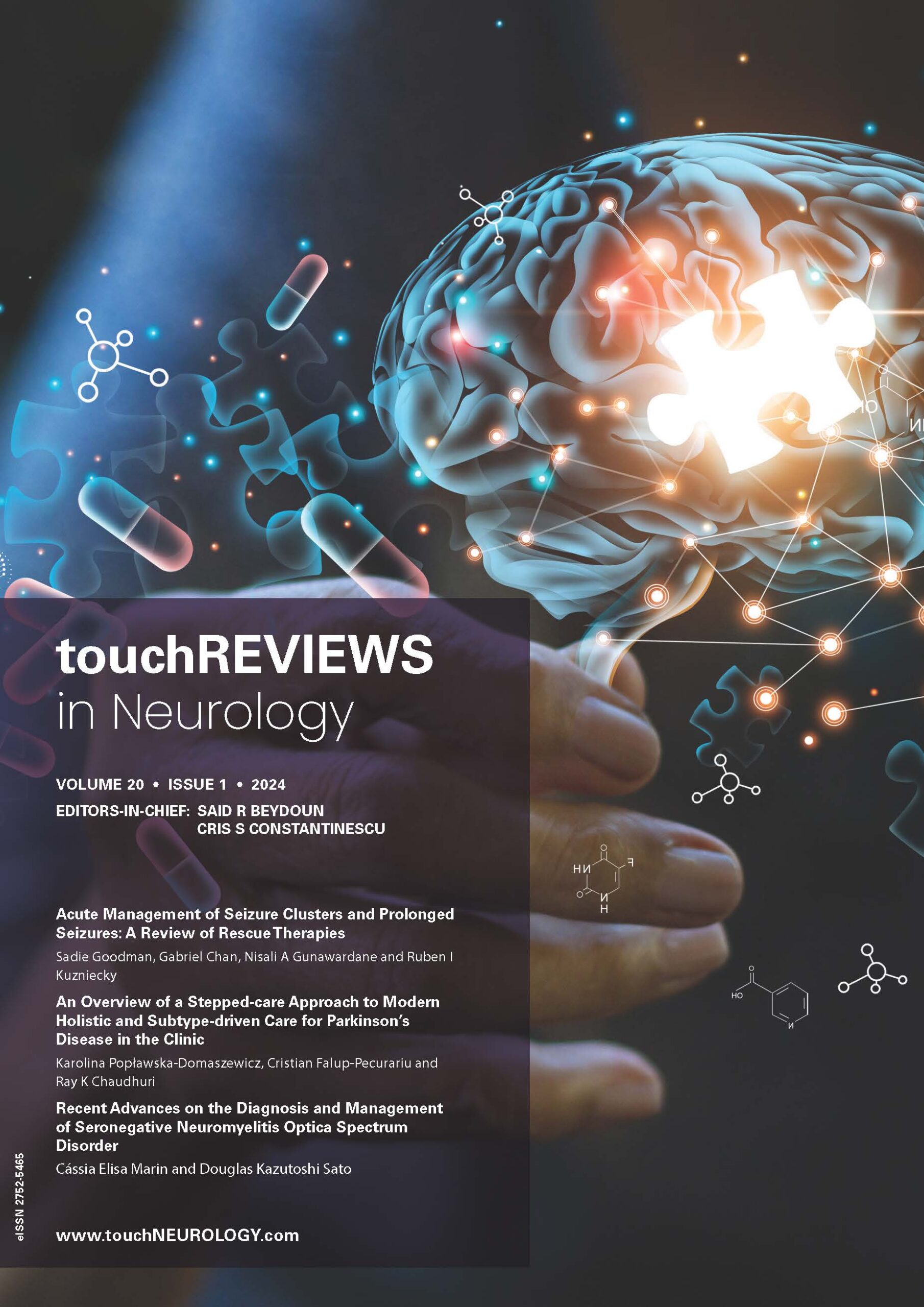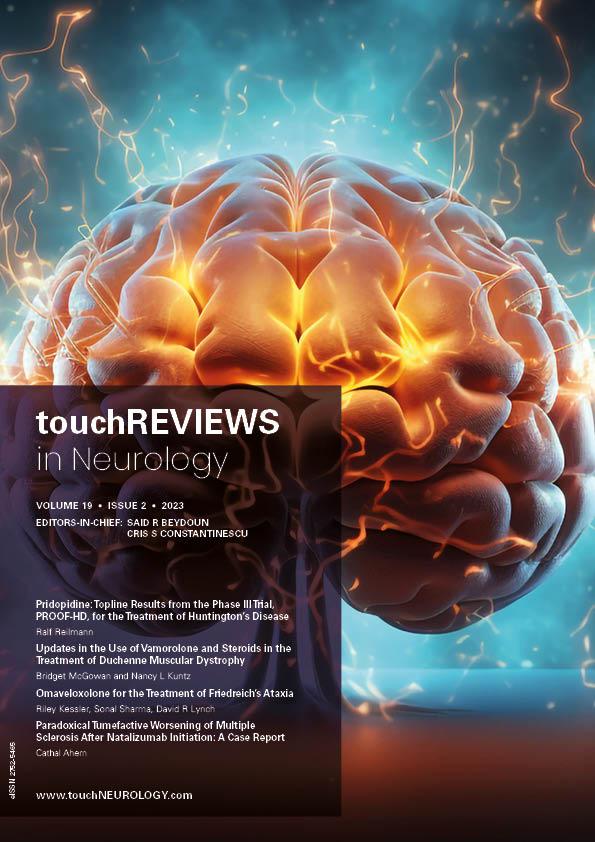
US NEUROLOGICAL DISEASE – VOLUME 1 – SPRING 2006
Welcome to the first edition of US Neurological Disease! The aim of the journal is to provide review articles containing the latest news and updates throughout neurology. In this edition we include articles on migraine, epilepsy, stroke and much more!
Migraine
Triptans The triptans—sumatriptan, zolmitriptan, naratriptan, rizatriptan, almotriptan, frovatriptan and eletriptan— revolutionized the acute treatment of migraine when they became available over a decade ago. They are used at headache onset, and are available in several forms. All are available as tablets, while two— zolmitriptan and rizatriptan—are also available in orally dissolvable tablets. Sumatriptan has an […]
Epilepsy
Several new AEDs—felbamate, gabapentin, lamotrigine, levetiracetam (LEV), oxcarbazepine, tiagabine, topiramate, vigabatrin, zonisamide, and gabitril are currently available by prescription in the US. Over the past decade alone, 10 new AEDs have been introduced; the efficacy of the newer agents is, to some extent, similar, but the adverse effects vary. LEV has a unique mechanism of […]
The concept of compliance is important because negative outcomes such as increased seizure frequency, increased hospital admissions, loss of driving privileges, loss of employment, status epilepticus, and death are often related to the inability to take medications as ordered (non-compliance). The findings of this literature review will be used to determine what is currently known […]
Since the problem is too complex to be solved by individual organizations, and to bring epilepsy ‘out of the shadows’, a Global Campaign Against Epilepsy was launched in 1997, “to improve acceptability, treatment, services, and prevention of epilepsy worldwide”.The campaign is conducted by the World Health Organization (WHO) in partnership with the International League Against […]
Seizures are the symptoms of a dysfunctional brain. They manifest in myriad different epilepsy syndromes with an equally wide variety of pathophysiologies. In the developed world, the majority of patients with newly diagnosed epilepsy will be started on a prophylactic treatment with an antiepilepticdrug (AED). AEDs can only suppress seizure activity after epilepsy has developed, […]
Multiple Sclerosis
Minocycline is a semi-synthetic tetracycline derivative that has been in clinical use for more than 30 years.The drug, which has broad-spectrum antimicrobial activity, is commonly used for the long-term treatment of chronic conditions such as acne vulgaris and rosacea at doses of 100–200mg/day.1 Drug-induced autoimmune syndromes have been reported rarely,2 in the order of one […]
A Reappraisal of the Definition of MS The definition of MS as a ‘relapsing-remitting disease of myelin secondary to inflammation’ has been challenged. Currently, most MS experts believe that a combination of inflammation and ‘apoptosis/ degeneration’ processes produce continual (not relapsing-remitting) disease activity in the brain, even between clinical attacks. This concept implies that, when […]
Recommendations The Executive Committee of the National Clinical Advisory Board of the National Multiple Sclerosis Society (NMSS) has adopted the following recommendations regarding use of the current multiple sclerosis (MS) diseasemodifying agents: (in alphabetical order) glatiramer acetate (Copaxone®), interferon beta 1a-intramuscular (Avonex®), interferon beta 1asubcutaneous (Rebif®), interferon beta 1b (Betaseron®), mitoxantrone (Novantrone®), and natalizumab (Tysabri®). […]
Stroke
Second, by bringing a new optimism to physicians and scientists, this discovery has attracted numerous clinical scientists to the field of stroke.Third, the use of intravenous tPA led to the creation of primary stroke centers in the US.2 This center designation allows a community to triage pre-hospital patients directly to centers that treat stroke with […]
For most patients, vestibular symptoms are episodic and are not continuous.The factors that precipitate symptoms may provide important clues as to the etiology of the attacks.Vertigo brought on by lying supine and turning to one side is typical of benign paroxysmal positional vertigo (BPPV). Other typical precipitating positions for BPPV include looking underneath a low […]
Alzheimer' Disease
This delay in recognition of AD as a major neurological disease of aging does not reflect its impact.There are the personal tragedies that accompany the disease—the tragedy of having one’s memories, accumulated over a lifetime, gradually stripped away; the tragedy of watching someone you have loved and admired slowly losing their powers of thought, language, […]
Estrogen-containing Hormone Therapy, Selective Estrogen Receptor Modulators, and Alzheimer’s Disease
A number of genetic and non-genetic factors may influence the development of AD. Mutations in genes on chromosomes 14, 1, and 21, which increase ß- amyloid deposition and lead to dementia symptoms before the age of 60, are inherited in an autosomal dominant manner. 2 These relatively rare mutations do not contribute to late-onset dementia, […]
MRI has gained widespread use in modern medicine, particularly in the neurosciences. It is not surprising, therefore, that such technology would eventually be applied to neurosurgical operations. What follows is an overview of the current applications of intra-operative MRI (iMRI), the surgical and engineering considerations surrounding its use, and a brief discussion of the future […]
Dementia is a term used to describe acquired cognitive impairments that interfere with day-to-day functioning. In addition to describing a clinical syndrome, dementia also refers to the disorders that cause cognitive impairment.AD is the most common form of dementia, representing about two-thirds of all cases. Vascular dementia, dementia associated Parkinson s disease, and related disorders […]
Immune-mediated Neurological Diseases
This effect manifests clinically as an anti-proliferative effect on T- and B-lymphocytes, inhibition of polyclonally activated B-lymphocyte antibody formation, decreased production of the inducible form of nitric oxide (NO) (reducing tissue damage by nitrites), and the prevention of glycosylation and expression of certain adhesion molecules on lymphocytes leading to decreased lymphocytic and monocytic recruitment and […]

Trending Topic
Chronic inflammatory demyelinating polyradiculoneuropathy (CIDP) is a rare, autoimmune neurological disorder in which peripheral nerve demyelination typically results in weakness, impaired limb sensation, fatigue and pain.1–4 CIDP may adversely affect activities of daily living, with a substantial impact on functional ability and psychological well-being.2–6 Primary treatment goals are reducing symptoms, improving functional status and maintaining long-term remission.7 The […]
Journal Archive
touchREVIEWS in Neurology is a peer-reviewed, free-to-access, bi-annual neurology journal comprising review articles, case reports, practice guides, theoretical discussions, and original research. It features balanced and comprehensive articles written by leading authorities, addressing the most important and salient developments in the field of neurology.
Latest articles videos and clinical updates - straight to your inbox
Log into your Touch Account
Earn and track your CME credits on the go, save articles for later, and follow the latest congress coverage.
Register now for FREE Access
Register for free to hear about the latest expert-led education, peer-reviewed articles, conference highlights, and innovative CME activities.
Sign up with an Email
Or use a Social Account.
This Functionality is for
Members Only
Explore the latest in medical education and stay current in your field. Create a free account to track your learning.





